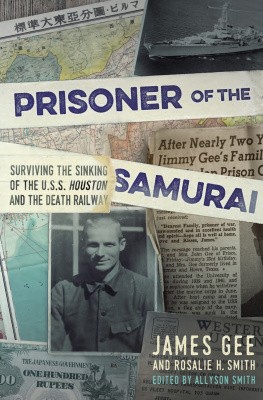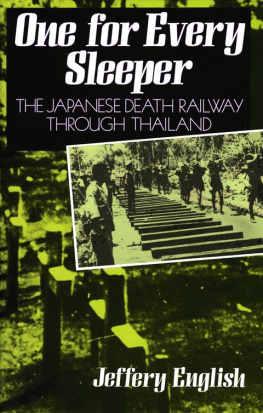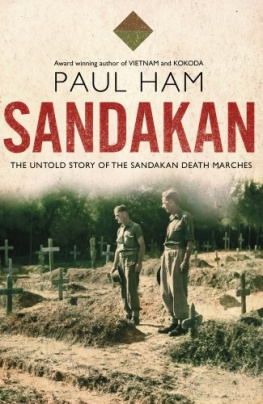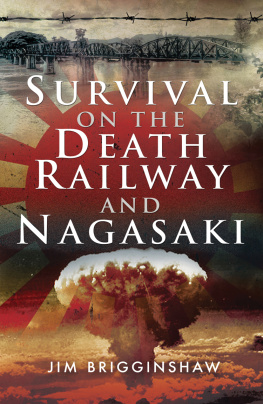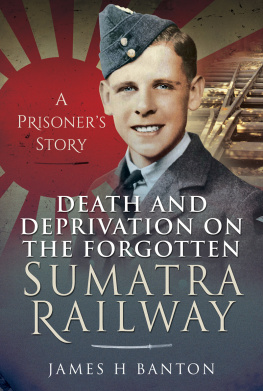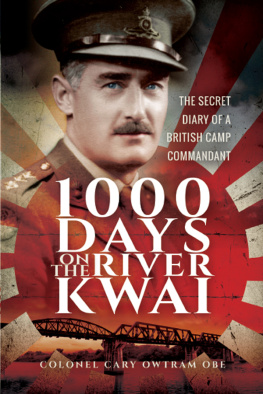
PRISONER OF THE SAMURAI
Surviving the Sinking of the USS Houston and the Death Railway
Rosalie H. Smith, RN
as related by James Wallace Gee, Private, USMC
All rights reserved, including without limitation the right to reproduce this ebook or any portion thereof in any form or by any means, whether electronic or mechanical, now known or hereinafter invented, without the express written permission of the publisher.
Copyright Casemate Publishers, Rosalie Hamric & Allyson Smith, 2018
ISBN: 978-1-4804-8261-6
Casemate Publishing
1950 Lawrence Road,
Havertown, PA 19083, USA
www.casematepublishing.com
This edition distributed in 2018 by Open Road Integrated Media
180 Maiden Lane
New York, NY 10038
www.openroadmedia.com

To the valiant crew of the U.S.S. Houston
Editors Note
During World War II, Lieutenant Rosalie Hamric was an R.N., serving as Charge Nurse in the Psychiatric Ward of the Guantanamo Bay Naval Hospital. At the end of the war, a group of liberated P.O.Ws from Southeast Asia (survivors of the sinking of the U.S.S. Houston ) was sent to this ward for treatment. Many were encouraged to write down their experiences as part of their therapy and for the sake of all those who did not make it to Guantanamo. One, James Gee, PFC, USMC did a particularly detailed job. During the course of his treatment, he and other POWs shared many of these experiences with Rosalie, who wove them into this account. After her death, the manuscript was found in an attic and, although its conclusions were made at the time of the Viet Nam War, the sentiments are just as timely in our day of wars and rumors of wars. This is especially true in light of the fact that 2017 is the 75th anniversary of the sinking of the Houston .
Special appreciation must be given to Craig Smith, he of the eagle eye, whose contributions are immeasurable in making this book clear, concise and accurate; to Brad Gee, who filled in so many gaps and provided photos of his father, and to the survivors of the sinking of the Houston , whose story of courage and tenacity this is.
Allyson Smith
Some names have been changed.
CHAPTER 1
The Honor
It was a hot, still afternoon in Austin, Texas. On the University grounds, not a leaf, twig or blade of grass moved. The heat was oppressive and enervating; it dulled the mind and weighted the spirit. From outside the open classroom window the sleepy-sounding buzz of bees floated into the room to compete with our English instructors reading of Byron. I had long planned a political career. While at the university I had made campaign speeches for one of the candidates for Lieutenant Governor. My father and Governor ODaniels had been friends since childhood and I could remember many good times in the Governors Mansion. Both the Governor and my father had encouraged my political ambitions. As a young fellow, I had informed them that I intended to be Governor of Texas one day.
Many of my classmates at the University of Texas had joined the Canadian Air Force, and had already seen much action in the European theater. Our sphere of operations was dead. Despite a constant threat, no war was in evidence. My immediate problem was to teach my ambition to conform to the facts. I had enjoyed Veblen, Montaigne, Kipling, Geography and a host of other somewhat more frivolous pursuits on campus, but, as Hitlers panzers rolled over country after country, it seemed abundantly evident that the United States would be involved at any moment. Several friends and I did manage to finish our second semester, but when June, 1940 arrived, we joined the U.S. Marine Corps.
There were approximately 1,000 men in the Asiatic Fleet. Out of this number, four sailors and three marines had been notified that they were to complete certain courses under a wardroom class with Marine Captain Ramsey. I was one of these. We were recruits for the Naval Academy at Annapolis.
I had been studying hard for three months. Then, we got our ship assignment: we were to have the honor of serving aboard the U.S.S. Houston .
She was big, very big and shed become famous; from Europe to Texas, through the Panama Canal and out to Honolulu. On February 22, 1931 the U.S.S. Houston joined the Asiatic Fleet in Manila, Philippine Islands, and assumed her role as flagship, hoisting the flag of Admiral Charles McVay, Jr. The flooding of the Yangtze River in September of that year necessitated the use of the Houston for rescue work; this flood was one of the most devastating in the history of that most renowned river. The Houston went up the river for about 600 miles, to the city of Hankow, returning to Shanghai on October 5, 1931.
During a routine overhaul in the Cavite Naval Yard, Philippine Islands, on the night of January 31, 1932, the Houston was given orders to proceed immediately to Shanghai. Hostilities had broken out between Japan and China. American lives and interests were endangered. Within two hours she sailed with 250 marines to augment the 4th Marine Regiment stationed in Shanghai. Although the weather conditions were rough, the ship broke all existing records, making the trip in 47 hours.
The Houston left Manila on March 13, 1933, on a goodwill tour through the southern Philippines, visiting Iloilo, Cebu, Davao, Dumanquilas Bay and Zamboango. On May 29, 1933 she made a goodwill tour to Japan, visiting Yokohama and Kobe, returning to Tsingtao, China by way of the Japanese Inland Sea. On November 17, 1933, she was relieved by the U.S.S. Augusta , and departed from Shanghai for San Francisco, visiting Yokohama en route. She was overhauled in the Puget Sound Navy yard, joining a scouting force of the U.S. fleet in Long Beach, California and departed with the fleet for Atlantic ports.
While at Annapolis, Maryland, on July 1, 1934, President Roosevelt came aboard the Houston , for a cruise of 11,783 miles. The party accompanying him consisted of his two sons, John, and Franklin Delano, Jr., his naval aide, Captain Wilson Brown, Mr. R. Forster, Executive Clerk, Commander Ross T. McIntyre (MC) U.S.N. plus R. Jervis and G. Gennerich of the U.S. Secret Service. The destroyers U.S.S. Gilmer and U.S.S. Williamson transported the press representatives, and acted as escorts until the Houston arrived at the Canal Zone where they were relieved by the cruiser U.S.S. New Orleans .
First stop was laid off Long Island, in the upper Bahamas, on July 4, while the President enjoyed a day of fishing. The first port of call was Cape Hatien, Haiti, where the President exchanged calls with President Vicente of Haiti. The next port was Mayguez, Puerto Rico, where the President and his entourage disembarked and motored across the island to rejoin the ships at San Juan. They proceeded to St. Thomas and St. Croix, Virgin Islands, and to Cartagena, Colombia, South America, where the President undertook a goodwill visit. The Houston stopped at Cristobal, Canal Zone, to allow the Hon. Mr. Dern, Secretary of War, to come aboard.
During passage through the canal, the military defense force was presented to the President and the Secretary of War, and was unanimously acclaimed for the excellent appearance of both personnel and fighting equipment. At Balboa, the President received on board the President of Balboa along with other prominent personages. At Cocos Island, famous as a buccaneer haunt, the President had another day of fishing. The Houston proceeded toward the next stop, and when approximately 1,000 miles from land, two land-based aircraft appeared, followed by the enormous dirigible U.S.S. Macon .
Next page
